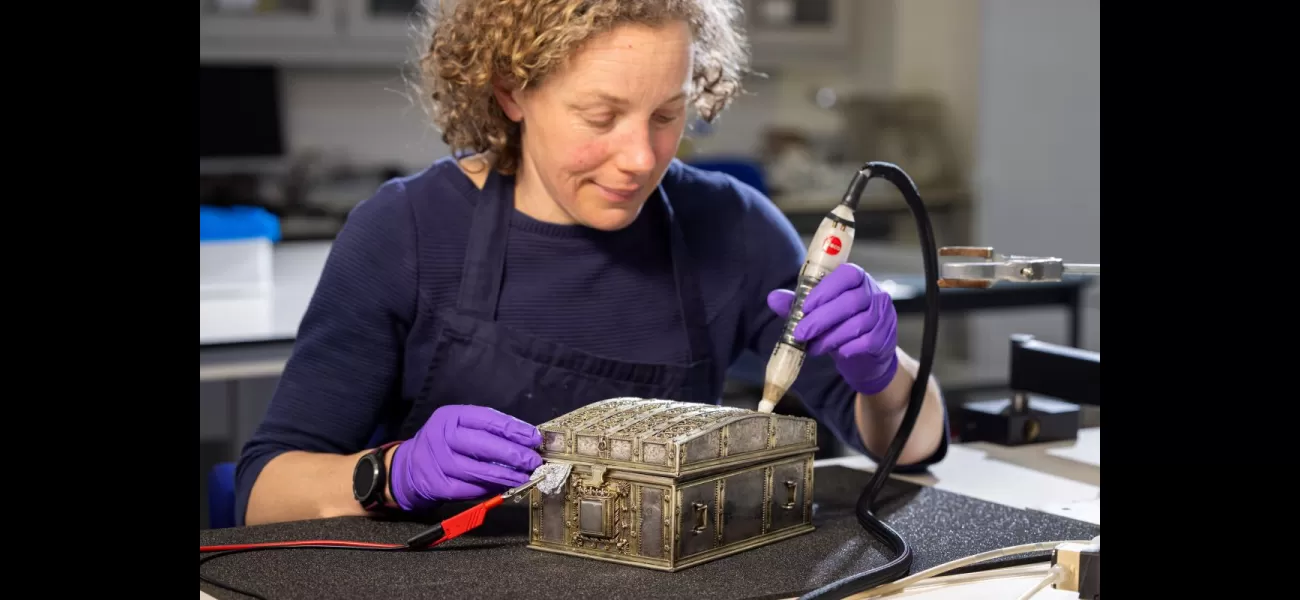Queen of Scots' silver casket to embark on tour of historic significance.
A rare silver casket, once owned by Mary, Queen of Scots, has undergone conservation work and will now tour Scotland. Made in Paris between 1493 and 1510, it is a unique piece of early French silver.
April 29th 2024.

A beautiful silver casket, believed to have been owned by the iconic Mary, Queen of Scots, has recently undergone a meticulous conservation process in preparation for its upcoming tour throughout Scotland. This exquisite piece, crafted in Paris between 1493 and 1510, is a rare and precious example of early French silver, with only a handful of similar works surviving even in its home country.
Historians speculate that the casket was gifted to Mary by her first husband, François II of France, and accompanied her to Scotland in 1561 after his untimely passing in 1560. Its remarkable journey and connection to Mary, spanning over four and a half centuries, is likely what has kept it in such excellent condition all these years.
For over three hundred years, the casket remained in the possession of the Dukes of Hamilton, who acquired it in 1674 through Anne, Duchess of Hamilton. A handwritten note, dating back to the late 17th century and found alongside the casket, reveals that it was previously owned by Mary, Marchioness of Douglas, and was purchased by Anne with the understanding that it had belonged to Mary, Queen of Scots. This note also mentions the infamous role the casket played in Mary's downfall, when it was presented as evidence against her in a hearing initiated by Elizabeth I in 1568.
The casket contained a series of love poems and letters, known as the Casket Letters, which were allegedly written by Mary to her third husband, the Earl of Bothwell. These letters were used to implicate the couple in a plot to murder Mary's second husband, Lord Darnley.
In 2022, the casket was acquired by National Museums Scotland for £1.8 million, and it will soon be on display at Kirkcudbright Galleries in Dumfries and Galloway from November 2nd until April 27th of next year. It will then move to the Stirling Smith Art Gallery & Museum from April 30th to August 31st of the same year.
To prepare the casket for its tour, experts carefully removed centuries of tarnish and corrosion using a technique called electrolytic reduction. This method, which involves a pen-like device, allows for precise and targeted cleaning without damaging the delicate gold and silver surfaces.
Dr. Anna Groundwater, acting keeper of Scottish history and archaeology at NMS, expressed her excitement for this precious item to be viewed by more people, stating, "One of Scotland's national treasures, this extraordinary casket has been venerated as a relic of Mary, Queen of Scots for centuries, and I'm delighted that more people will have the opportunity to see it up close when it goes on tour later this year." She also noted that the casket is not only significant for its connection to Mary, but also as a rare and stunning piece of historic silver in its own right.
The casket first appeared in historical records after Mary's arrest in 1567, when it was discovered in the possession of Lord Bothwell's servant. It was presented before the Scottish Privy Council, where its lock was broken to reveal its contents, which remain a mystery to this day. However, a year later, during a dramatic hearing at Westminster, the casket was produced once again, this time containing the incriminating Casket Letters.
The authenticity of these letters has been a topic of debate, with many believing them to be altered. After the hearing at Westminster, Mary spent 19 years in English captivity before being executed in 1587 for her involvement in the Babington Plot to assassinate Elizabeth I and claim the English throne.
Caroline Mathers, director of the Stirling Smith Art Gallery and Museum, expressed her enthusiasm for the casket's visit, saying, "The Smith Art Gallery and Museum is delighted to be partnering with the National Museum of Scotland to bring the Mary, Queen of Scots Casket to Stirling. This extraordinary treasure gives us a glimpse into the life of a Queen who has captured imaginations around the world for hundreds of years. A story of power, oppression, and ultimately, betrayal. It's as good a story as it gets."
Experience more fascinating news stories like this by subscribing to Scottish Field and reading the latest issue.
Historians speculate that the casket was gifted to Mary by her first husband, François II of France, and accompanied her to Scotland in 1561 after his untimely passing in 1560. Its remarkable journey and connection to Mary, spanning over four and a half centuries, is likely what has kept it in such excellent condition all these years.
For over three hundred years, the casket remained in the possession of the Dukes of Hamilton, who acquired it in 1674 through Anne, Duchess of Hamilton. A handwritten note, dating back to the late 17th century and found alongside the casket, reveals that it was previously owned by Mary, Marchioness of Douglas, and was purchased by Anne with the understanding that it had belonged to Mary, Queen of Scots. This note also mentions the infamous role the casket played in Mary's downfall, when it was presented as evidence against her in a hearing initiated by Elizabeth I in 1568.
The casket contained a series of love poems and letters, known as the Casket Letters, which were allegedly written by Mary to her third husband, the Earl of Bothwell. These letters were used to implicate the couple in a plot to murder Mary's second husband, Lord Darnley.
In 2022, the casket was acquired by National Museums Scotland for £1.8 million, and it will soon be on display at Kirkcudbright Galleries in Dumfries and Galloway from November 2nd until April 27th of next year. It will then move to the Stirling Smith Art Gallery & Museum from April 30th to August 31st of the same year.
To prepare the casket for its tour, experts carefully removed centuries of tarnish and corrosion using a technique called electrolytic reduction. This method, which involves a pen-like device, allows for precise and targeted cleaning without damaging the delicate gold and silver surfaces.
Dr. Anna Groundwater, acting keeper of Scottish history and archaeology at NMS, expressed her excitement for this precious item to be viewed by more people, stating, "One of Scotland's national treasures, this extraordinary casket has been venerated as a relic of Mary, Queen of Scots for centuries, and I'm delighted that more people will have the opportunity to see it up close when it goes on tour later this year." She also noted that the casket is not only significant for its connection to Mary, but also as a rare and stunning piece of historic silver in its own right.
The casket first appeared in historical records after Mary's arrest in 1567, when it was discovered in the possession of Lord Bothwell's servant. It was presented before the Scottish Privy Council, where its lock was broken to reveal its contents, which remain a mystery to this day. However, a year later, during a dramatic hearing at Westminster, the casket was produced once again, this time containing the incriminating Casket Letters.
The authenticity of these letters has been a topic of debate, with many believing them to be altered. After the hearing at Westminster, Mary spent 19 years in English captivity before being executed in 1587 for her involvement in the Babington Plot to assassinate Elizabeth I and claim the English throne.
Caroline Mathers, director of the Stirling Smith Art Gallery and Museum, expressed her enthusiasm for the casket's visit, saying, "The Smith Art Gallery and Museum is delighted to be partnering with the National Museum of Scotland to bring the Mary, Queen of Scots Casket to Stirling. This extraordinary treasure gives us a glimpse into the life of a Queen who has captured imaginations around the world for hundreds of years. A story of power, oppression, and ultimately, betrayal. It's as good a story as it gets."
Experience more fascinating news stories like this by subscribing to Scottish Field and reading the latest issue.
[This article has been trending online recently and has been generated with AI. Your feed is customized.]
[Generative AI is experimental.]
0
0
Submit Comment





